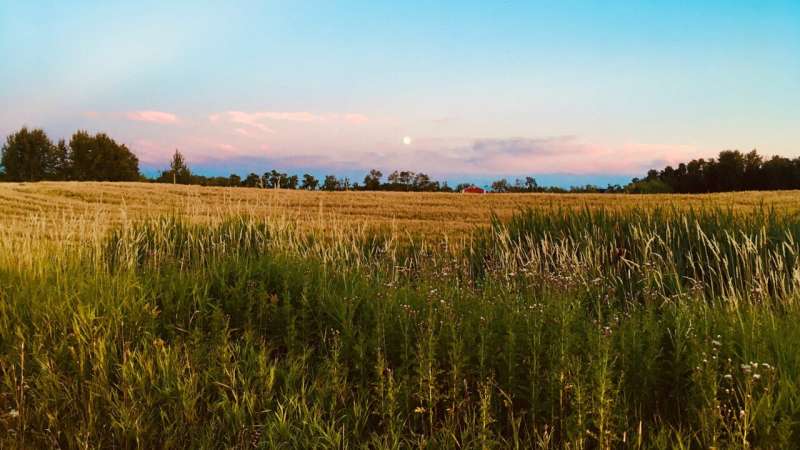Woodlands next to agricultural land stored two to three times more carbon than neighbouring fields and reduced emissions of nitrous oxide by an average of 89 per cent, according to a U of A study. Credit: University of Alberta
Both dead and alive, trees are an important ally for farmers in helping the environment, a new University of Alberta study shows. The research appears in Global Change Biology.
Preserving and planting shelterbelts and hedgerows—and keeping the deadwood they contain—next to cropland helps store carbon and reduce greenhouse gas emissions.
"Retaining those live and dead trees, and planting more trees where possible on agricultural lands, is a valuable way to help mitigate climate change," says lead author Cole Gross, post-doctoral researcher at Yale University's School of the Environment, who conducted the study while completing his Ph.D. in soil science in the Faculty of Agricultural, Life & Environmental Sciences.
In the three-year study, researchers looked at several central Alberta cropland sites and their nearby woodlands: shelterbelts, which are rows of planted trees, and hedgerows, which are naturally occurring trees and wild bushes. The results show that shelterbelts and hedgerows stored two and three times more carbon, respectively, than neighboring fields of wheat, barley and canola.
The two types of woodlands also reduced emissions of nitrous oxide, a potent greenhouse gas, by an average of 89% over the three years of the study, compared with the nearby cropland.
The research, which is the first to explore the benefits of deadwood in shelterbelts and hedgerows, shows that the material plays a valuable role in storing carbon—meaning farmers should let it lie.
"Clearing out live and even dead trees from shelterbelts and hedgerows has detrimental effects on carbon storage. Deadwood plays a valuable role, particularly in hedgerows, and likely provides additional benefits such as enhancing biodiversity," Gross says.
The researchers also explored the effect of planting saplings in grassland gaps within the woodlands, but found no significant effect on carbon storage or greenhouse gas emissions in the initial three years following planting.
That finding provides another reason to retain existing woodlands, Gross says.
"Planting trees is going to take decades to show really substantial increases in carbon storage, so we need to preserve what we have now."
In addition to maintaining existing woodlands, farmers should also consider planting more shelterbelts along the roadside margins of their fields, he suggests.
"It can really help with the overall sustainability and environmental impact of that land."
Gross says offering tax reductions, carbon credits, grants or other resources could help encourage retention and planting of hedgerows and shelterbelts.
More information: Cole D. Gross et al, Agroforestry perennials reduce nitrous oxide emissions and their live and dead trees increase ecosystem carbon storage, Global Change Biology (2022). DOI: 10.1111/gcb.16322
Journal information: Global Change Biology
Provided by University of Alberta























